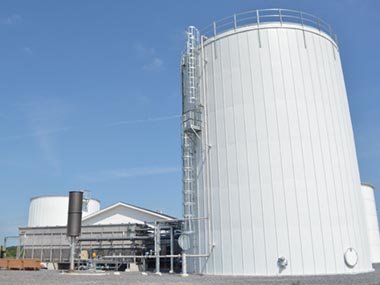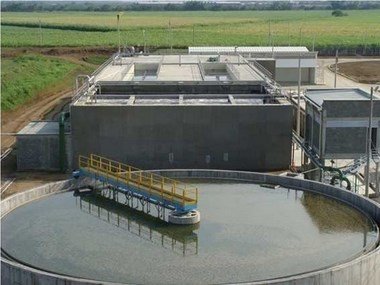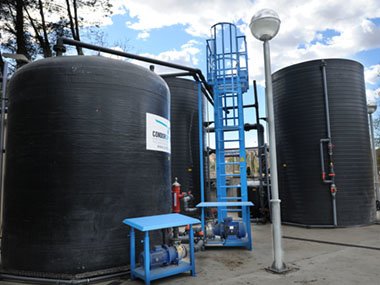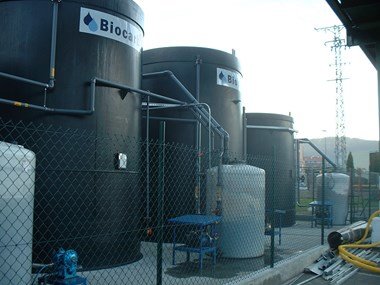Biological wastewater treatment plant design
At Condorchem Envitech, we offer various types of biological reactors for treating wastewater generated in industrial processes. Each of our biological reactors is designed and manufactured based on the characteristics of the wastewater, always considering the specific needs and objectives specified by our clients.
We have extensive experience in the design, manufacturing, assembly, and commissioning of different types of biological wastewater treatment systems, ensuring that we always provide the most optimal process for each particular case.
It has a wide experience with are the following treatments:
- Aerobic reactors
- Anaerobic reactors
We have membrane biological reactors (MBR), moving bed bioreactors (MBBR) and sequential membrane reactors (SBR) for the design of our biological wastewater treatment plants:
Active sludge reactor
A continuous aerobic biological wastewater treatment process with the biomass in suspension. Efficient and viable is there is space.
Sequential biological reactor (SBR)
This type of reactor operates discontinuously and all the processes occur in the same tank sequentially in time. It is a good option for those industries that produces small effluents but with high variability as regards their characteristics.
Membrane biological reactor (MBR)
A membrane bioreactor (MBR system) is similar to the active sludge one with the difference that it has a module of ultrafiltration membranes in its interior. This module makes it possible to separate the sludge and the liquid using membranes, obtaining important advantages compares to traditional secondary decanters. It is an option for those cases in which there is little space
Mobile bed biological reactor (MBBR)
This reactor is similar to the conventional active sludge one with the difference that it has a module of ultrafiltration membranes in its interior. This module makes it possible to separate the sludge and the liquid using membranes, obtaining important advantages compared to traditional secondary decanters. It is an option for those cases in which there is little space.
BIOCARB®
It is an exclusive model patented by Condorchem Envitech and is based on the development of a fixed-bed aerobic reactor whose filler material is granulated lignite coal.
The coal filters, adsorbs and acts as a support for the biofilm, as well as feeding the microorganisms with minerals and trace elements. On the other hand, the adsorption process makes a double contribution to the process by rolling the peaks of pollutant load and by making the residence time of the pollutants in the interior of the reactor increase, such that it is possible to degrade persistent organic compounds.
The BioCarb® reactor has been shown to be especially effective in the treatment of pollutants that are difficult to biodegrade and with colour. Moreover, the immobilisation of the biomass on the surface of the lignite coal makes it possible to carry out in a single stage a biological and physical-chemical treatment of wastewater.
UASB Reactor
An anaerobic process, ideal for effluents with high organic loads. Very low operating costs.
RAFAC® Reactor
An anaerobic process, optimized to treat high organic loads. A very competitive process.
Our Biological digesters
Advantages
- Biological treatment is the most economical technique for removing biodegradable contamination from wastewater
- It is a treatment applicable to a wide variety of wastewater types
- The operation is simple and mostly automated
- It produces an effluent that can be reused via tertiary processes
- There are intensive processes where a large space is not required to carry out the satisfactory treatment of large flows
- In the case of anaerobic treatment, sludge production is minimized and biogas can be generated, which is valuable and constitutes an important energy resource
Applications
- Urban wastewaters
- Domestic and small community wastewater
- Industrial water from the food industry
- Wastewater from the textile industry
- Wastewater from farms and slaughterhouses
Introduction to technology
When wastewater have a high concentration of dissolved organic matter, the most competitive option is biological treatment, due to its simplicity and low costs. The only requirements for satisfactorily applying this technology is that the pollution be biodegradable and that there no biocidal compound be present in the effluent to be treated.
The biological treatment of wastewater is based on the ability of a set of microorganisms that are capable of degrading the organic matter present in the wastewater for its own growth. Apart from organic matter, microorganisms need water containing nutrients, basically nitrogen and phosphorus, to grow. Subsequently, the separation of these microorganisms from water is simple and economical. Thus, microorganisms are responsible for removing the organic matter present in water, both particulate and soluble.
The set of microorganisms is very varied and rich in species and its exact composition depends on the properties of the wastewater being treated and the process conditions; as it is a kind of ecosystem that adapts continuously to changing external conditions.
The removal of biodegradable organic matter, as well as nitrogen and phosphorus, through wastewater biological treatment is the most economical and simplest way to treat effluents. For this reason, it is the treatment applied mostly for both urban and industrial wastewater.
The limitations of this type of treatment are related to the biodegradability of the contaminants and the presence in the effluent of substances inhibiting the growth of microorganisms (biocides).
Functioning/operation of technology
Microorganisms can degrade organic matter by using oxygen (aerobic growth) or not (anaerobic growth), using two very different types of metabolic pathways that have practical consequences. Whenever microorganisms have oxygen they will grow using aerobic metabolism, as this provides them with the most energy. Anaerobic metabolism is activated only in those conditions where microorganisms do not have enough oxygen. If they have nutrients, this gives the cells the ability to continue growing, but with a very low energy yield.
The selection of the type of biological process must be analyzed case-by-case according to the characteristics of the effluent to be treated.
Aerobic wastewater treatments, or biological oxidation wastewater treatments, are based on the ability of microorganisms to degrade organic matter using oxygen as an electron acceptor. This allows the cells to achieve high energy yields, which leads to the production of a significant generation of sludge.
There are different types of aerobic biological treatments; the most important being:
- Conventional process (activated sludge): In this aerobic biological treatment of wastewater, the biomass grows freely, or in suspension, inside the biological reactor, and forms flocs. It is a widely used and easy to control system.
- Sequential reactors (SBR): SBR treatment it’s a batch operation and all processes are carried out sequentially over time in the same tank. It is a good option for those industries that produces small effluents but with high variability as regards their characteristics.
- Biomembrane reactors (MBR): The treatment is analogous to the conventional process, but with the difference that it has an ultrafiltration membrane module inside. This module makes it possible to separate the sludge and the liquid using membranes, obtaining important advantages compares to traditional secondary decanters. It is an option for those cases in which there is little space.
- BIOCARB®: It is a process patented by Condorchem Envitech and is based on the development of a fixed-bed aerobic reactor whose filler material is granulated lignite coal. The coal filters, adsorbs and acts as a support for the biofilm, as well as feeding the microorganisms with minerals and trace elements. On the other hand, the adsorption process makes a double contribution to the process by rolling the peaks of pollutant load and by making the residence time of the pollutants in the interior of the reactor increase, such that it is possible to degrade persistent organic compounds. TheBioCarb® reactor has been shown to be especially effective in the treatment of pollutants that are difficult to biodegrade and with color. Moreover, the immobilization of the biomass on the surface of the lignite coal makes it possible to carry out in a single stage a biological and physical-chemical treatment of wastewater. In other words, a wastewater treatment physical chemical biological process
- Biodiscs: This is a process where the biomass is immobilized, as many of the fixed film biological reactors do. Specifically, it grows adhered to a set of discs (also called rotating biological contactors) that revolve around a horizontal axis, located inside the reactor. A bacterial biomass film gradually forms on this medium, and uses the soluble organic matter present in the wastewater as a substrate for its metabolism. When the surface of the disc is in contact with the air, the biomass adhering to the disc takes the oxygen necessary for the degradation of the organic matter present in the wastewater during the immersion period.
- Trickling filters: After decanting, the wastewater to be treated is distributed over the top of a filter, filled with a support, which may be sand or gravel, for example. As the water descends through the interstitial spaces of the filter, the organic matter is degraded by the biomass growing attached to the filter filler particles.
- Mobile bed filters (MBBR): The biomass that degrades the organic matter is adhered in the form of a biofilm on high specific surface supports (trickling filter). These supports are submerged inside the moving bed biological reactor in continuous movement.
Anaerobic treatments allow the degradation of organic matter in the absence of oxygen. This fact means that the production of sludge is very low, compared to an aerobic process, and to biogas production, which may be valued. In contrast, the removal of nutrients is not possible only through an anaerobic process.
- BIOCARB®: An aerobic biological process with fixed biomass. Very efficient and complete treatment. An excellent option in many cases.
- UASB Reactor: An anaerobic process, ideal for effluents with high organic loads. Very low operating costs.
- RAFAC® Reactor: An anaerobic process, optimized to treat high organic loads. A very competitive process.





